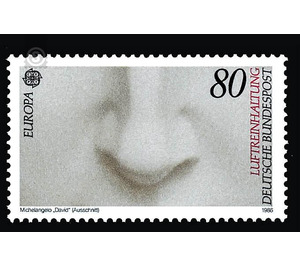Europe - Germany / Federal Republic of Germany 1986 - 80 Pfennig
Theme: Health & Human
| Country | Germany / Federal Republic of Germany |
| Issue Date | 1986 |
| Face Value | 80.00 |
| Color | white |
| Perforation | K 14 |
| Printing Type | 4-color rotogravure |
| Stamp Type | Postage stamp |
| Item Type | Stamp |
| Chronological Issue Number | 1152 |
| Chronological Chapter | GER-BRD |
| SID | 249085 |
| In 43 Wishlists | |
In the context of the XI. At the Ordinary General Assembly in Vienna, the European Conference of Postal and Telecommunications Administrations (CEPT) has chosen the common theme "Nature and Environment" for the European brands in 1986. The German Federal Post Office addresses with "water conservation" and "clean air" two areas that are at the center of efforts. Every person inhales 7 to 14 cubic meters of air a day. The air consists essentially of nitrogen (77%) and oxygen (21%). In pure composition, the air is - at least in industrialized countries - rarely found. Pollution of the air by man has a long tradition. For centuries, the smoking fireplace has signaled warmth, work and prosperity. Just as old are the complaints about the annoyance caused by smoke, exhaust fumes and odors. Already in ancient Rome processes were conducted. The philosopher Seneca complained about the "heavy air" in Rome and the stink of chimneys. The enormous economic development, especially after the Second World War, which has brought us prosperity and a high standard of living, has also increased the pollution of the air. The federal government is launching a broad-based program against air pollution. A targeted pension policy, which starts at the sources of air pollution, is intended to reduce the pollution levels step by step. It covers all groups of polluters: energy production, industry, households and transport. The entire package of measures will lead to a reduction in pollutant emissions. Important international agreements have also been reached in air pollution control. In Helsinki in July 1985 21 states from the West and East committed themselves to reduce national annual sulfur emissions or their cross-border flows as soon as possible and by at least 30% by 1993 at the latest. The decisive impetus for this was the Multilateral Munich Environmental Conference of June 1984, to which the Federal Government had invited. So the air we breathe on a daily basis will become cleaner. This is for the protection of human health, the protection of animals and plants, the preservation of buildings and monuments and last but not least the protection of forests. The motif shows excerpts from the 1501 - 1504 "David" by Michelangelo, Florence, Galleria dell 'Accademia. Mouth and nose are symbols of the pollutant load experienced by the senses and are intended to make it clear that in all efforts to protect the environment the human being is the center of attention and that all efforts are ultimately made for his health and the continued existence of mankind. (Text: Federal Ministry of the Interior, Bonn)


